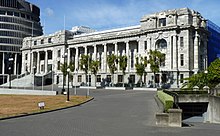This article needs additional citations for verification. (August 2014) |
| 43rd Parliament of New Zealand | |||||
|---|---|---|---|---|---|
| |||||
 | |||||
| Overview | |||||
| Legislative body | New Zealand Parliament | ||||
| Term | 28 November 1990 – 23 September 1993 | ||||
| Election | 1990 New Zealand general election | ||||
| Government | Fourth National Government | ||||
| House of Representatives | |||||
 | |||||
| Members | 97 | ||||
| Speaker of the House | Robin Gray | ||||
| Leader of the House | Don McKinnon — Paul East until 27 March 1993 | ||||
| Prime Minister | Jim Bolger | ||||
| Leader of the Opposition | Mike Moore | ||||
| Sovereign | |||||
| Monarch | Elizabeth II | ||||
| Governor-General | Catherine Tizard — Paul Reeves until 29 November 1990 | ||||
| Sessions | |||||
| |||||
The 43rd New Zealand Parliament was a term of the Parliament of New Zealand. Its composition was determined by the 1990 elections, and it sat until the 1993 elections.
The 43rd Parliament saw the beginning of the fourth National Party government, with the Labour Party failing to win a third term in office. The 43rd Parliament was heavily dominated by National, which controlled nearly seventy percent of the seats. Only one minor party, Jim Anderton's NewLabour, was present at the beginning of the 43rd Parliament. Later, NewLabour would join with several unrepresented parties to form the Alliance, which would gain two additional seats when two National MPs defected. Another National MP, Winston Peters, would also break away from his party, becoming an independent.
The 43rd Parliament consisted of ninety-seven representatives, the same as the previous Parliament. All of these representatives were chosen by single-member geographical electorates, including four Māori electorates.